Mini-Reactor Proliferation-Resistant Fuel with Burnable Gadolinia in Once-Through Operation Cycle Performance Verification
Abstract
:1. Introduction
2. Materials and Methods
3. Results and Discussion
3.1. Fuel Burnup Performance
3.2. Fission Power Profile and Uranium Depletion
3.3. Burnable Adbsorber Depletion
3.4. Neptunium and Plutonium Content
4. Conclusions
Author Contributions
Funding
Data Availability Statement
Conflicts of Interest
References
- Virgili, N. The Impact of Small Modular Reactors on Nuclear Non-Proliferation and IAEA Safeguards; Vienna Center for Disarmament and Non-Proliferation: Vienna, Austria, 2020. [Google Scholar]
- Godsey, K.M. Life Cycle Assessment of Small Modular Reactors Using U.S. Nuclear Fuel Cycle. Marster’s Thesis, Environmental Health Physics, Clemson University, Clemson, SC, USA, 2019. [Google Scholar]
- Mignacca, B.; Locatelli, G. Economics and Finance of Small Modular Reactors: A Systematic Review and Research Agenda. Renew. Sust. Energy Rev. 2020, 118, 109519. [Google Scholar] [CrossRef]
- Chang, G.S. Enhancing PWR High Burnup Proliferation Resistance Fuel with Minor Actinides. Trans. Am. Nucl. Soc. 2007, 96, 759–762. [Google Scholar]
- Chang, G.S. Enhancing BWR Proliferation Resistance Fuel with Minor Actinides. J. Nucl. Mater. 2009, 385, 157–160. [Google Scholar] [CrossRef]
- Chang, G.; Foster, J.; Harrell, J. Mini-SMR-21 in Once-through Long-Lived Fuel Cycle Feasibility Assessment. Trans. Am. Nucl. Soc. 2020, 122, 675–678. [Google Scholar] [CrossRef]
- Bess, J.D.; Chang, G.S.; Moo, P.; Foster, J. Verification of Mini-Reactor Minor-Actinide Proliferation Resistant Fuel with Burnable Gadolinia in Once-Through Operation Cycle Performance. In Proceedings of the PBNC 2024, Idaho Falls, ID, USA, 7–10 October 2024. [Google Scholar]
- Serfontein, D.E.; Muldur, E.J.; Reitsma, F. Assessment and Reduction of Proliferation Risk Reactor-Grade Plutonium Regarding Construction of ‘Fizzle Bombs’ by Terrorist. Nucl. Eng. Des. 2014, 271, 545–551. [Google Scholar] [CrossRef]
- Dodd, B.; Britt, T.; Lloyd, C.; Shah, M.; Goddard, B. Novel Homogeneous Burnable Poisons in Pressurized Water Reactor Ceramic Fuel. Nucl. Eng. Technol. 2020, 52, 2874–2879. [Google Scholar] [CrossRef]
- Chang, G.S.; Bess, J.D.; Moo, P.; Hiruta, M.; Foster, J. PWR Minor Actinide Proliferation Resistant Fuel in Once-Through Fuel Cycle Performance Assessment. Trans. Am. Nucl. Soc. 2023, 129, 1004–1006. [Google Scholar]
- Bess, J.D.; Chang, G.; Hiruta, M.; Foster, J. SMR LEU+ Very Long-Lived Once-through Fuel Cycle Spent Fuel Inventory Reduction Verification. In Proceedings of the WM2023, Phoenix, AZ, USA, 26 February–2 March 2023. [Google Scholar]
- Lam, H.; Konig, A.; Wagener, C.; Franceschini, F. Westinghouse Advanced Fuel Management Strategies Leveraging High Enrichment and High Burnup Fuel to Optimize PWR Economics. In Proceedings of the PHYSOR 2022, Pittsburgh, PA, USA, 15–20 May 2022. [Google Scholar] [CrossRef]
- Chang, G.; Foster, J.; Harrell, J. Validation of an SMR Gadolinia Burnable Absorber Loading Design with No-Onsite Refueling and Penalty-Free Reactivity. In Proceedings of the PHYSOR 2022, Pittsburgh, PA, USA, 15–20 May 2022. [Google Scholar] [CrossRef]
- Chang, G.; Hiruta, M.; Foster, J.; Harrell, J. New Burnable Absorber Loading Design in SMR No-Onsite Refueling Strategy Performance Assessment. Trans. Am. Nucl. Soc. 2021, 125, 1049–1052. [Google Scholar]
- Baum, E.M.; Ernesti, M.C.; Knox, H.D.; Miller, T.R.; Watson, A.M.; Travis, S.D. Nuclides and Isotopes Chart of the Nuclides, 17th ed.; Bechtel Marine Propulsion Corporation: Schenectady, NY, USA, 2010. [Google Scholar]
- X-5 Monte Carlo Team. MCNP—A General Monte Carlo N-Particle Transport Code, Version 5; Volumes I (LA-UR-03-1987) and II (LA-CP-03-0245); [Revised 6/30/2004]; Los Alamos National Laboratory: Los Alamos, NM, USA, 2003. [Google Scholar]
- Ludwig, S.B.; Croft, A.G. To Manneschmidt, J. Letter Report, “Revision to ORIGEN2—Version 2.2”; Oak Ridge National Laboratory: Oak Ridge, TN, USA, 2002. [Google Scholar]
- Chang, G.S. Advanced CANDU Reactors Axial Xenon Oscillation Controllability Validation. Ann. Nucl. Energy 2016, 96, 441–445. [Google Scholar] [CrossRef]
- Chang, G.S. PWR Advanced Fuel High Burnup-Dependent Xenon Oscillation Controllability Assessment. Ann. Nucl. Energy 2019, 124, 592–605. [Google Scholar] [CrossRef]
- Chang, G.S.; Peterson, R.C. Burnup-Dependent Rim-Effect Comparison of WG-MOX Fuel Pellet in ATR and PWR. Trans. Am. Nucl. Soc. 2004, 90, 555–557. [Google Scholar]
- Chang, G.S.; Peterson, R.C. Validation of Radial Power Profile in FRAPCON-3 by Monte-Carlo Method. Trans. Am. Nucl. Soc. 2001, 85, 385–386. [Google Scholar]
- Chang, G.S.; Peterson, R.C. Weapons-Grade MOX Fuel Burnup Validation in ATR. Trans. Am. Nucl. Soc. 2001, 84, 239–240. [Google Scholar]
- Chadwick, M.B.; Obložinský, P.; Herman, M.; Greene, N.M.; McKnight, R.D.; Smith, D.L.; Young, P.G.; MacFarlane, R.E.; Hale, G.M.; Frankle, S.C.; et al. ENDF/B-VII.0: Next Generation Evaluated Nuclear Data Library for Nuclear Science and Technology. Nucl. Data Sheets 2006, 107, 2931–3060. [Google Scholar] [CrossRef]
- Kim, K.-O.; Jo, D. Analysis of Doppler Coefficients for Typical PWR UO2 and MTR U3Si2-Al Fuels Using ENDF/B-VI and VII. Ann. Nucl. Energy 2015, 85, 1024–1028. [Google Scholar] [CrossRef]
- Chang, G.; Foster, J.; Harrell, J. PWR Integral Gadolinia Burnable Absorber Loading Design in a Once-through Core Reactivity Swing Minimization Assessment. Trans. Am. Nucl. Soc. 2020, 123, 1419–1422. [Google Scholar] [CrossRef]
- Brown, N.R.; Worrall, A.; Todosov, M. Impact of Thermal Spectrum Small Modular Reactors on Performance of Once-through Nuclear Fuel Cycles with Low-Enriched Uranium. Ann. Nucl. Energy 2017, 101, 166–173. [Google Scholar] [CrossRef]

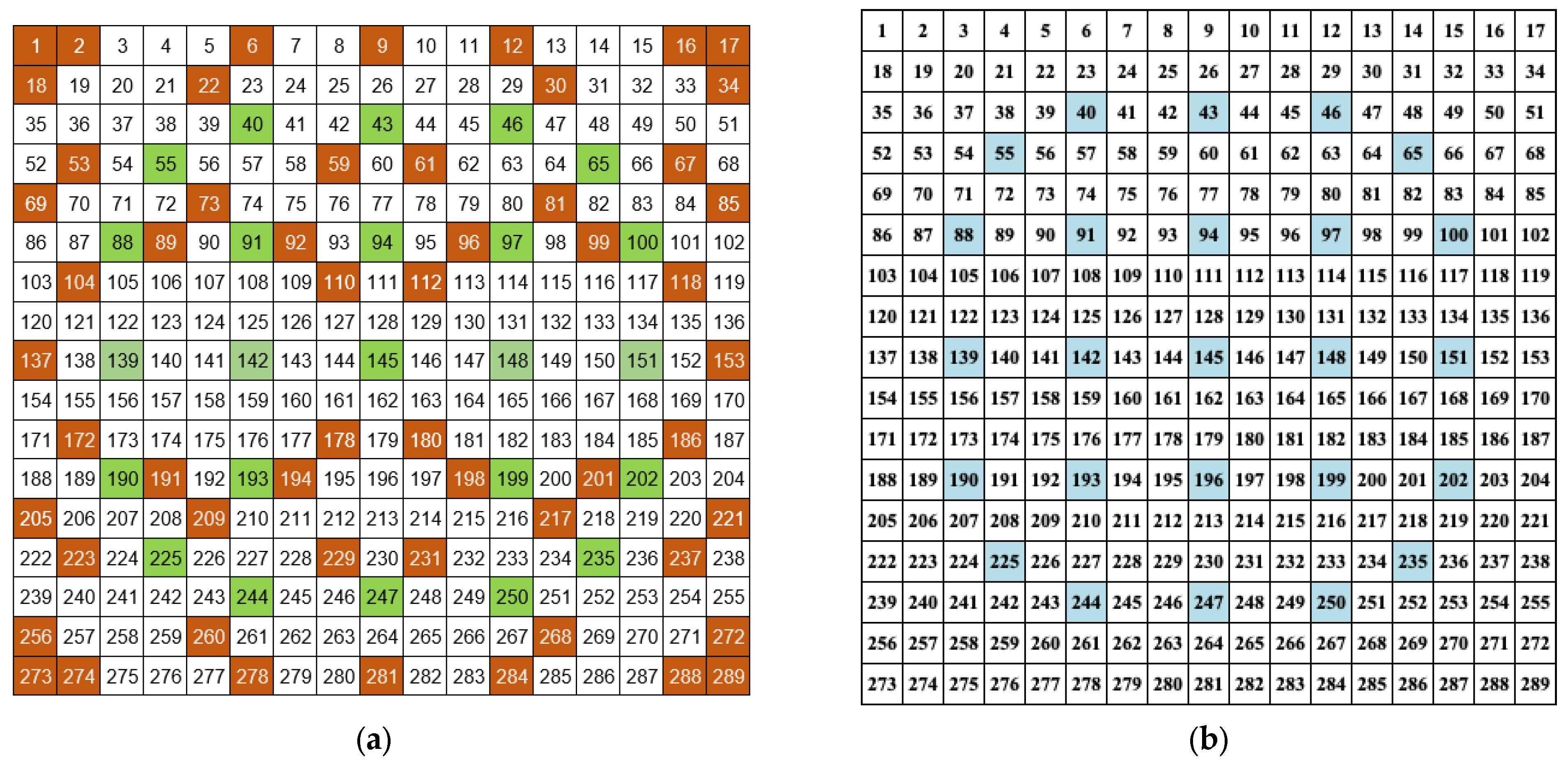

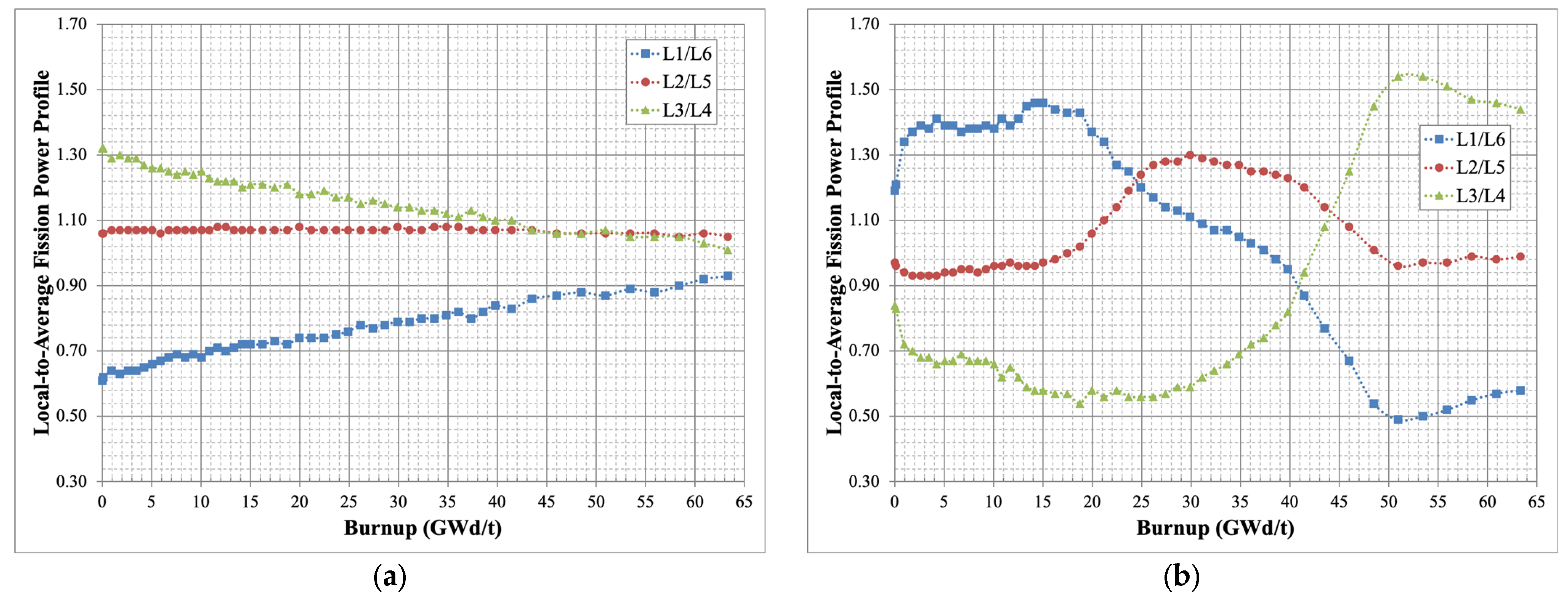
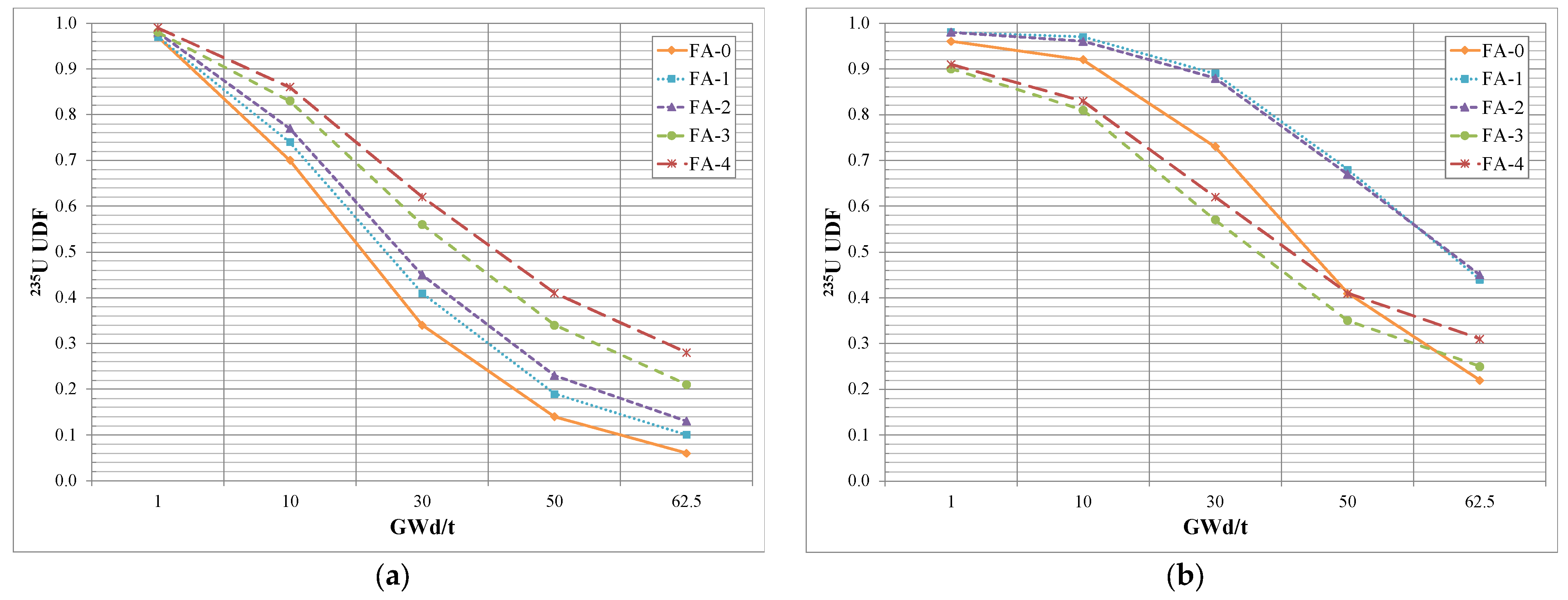
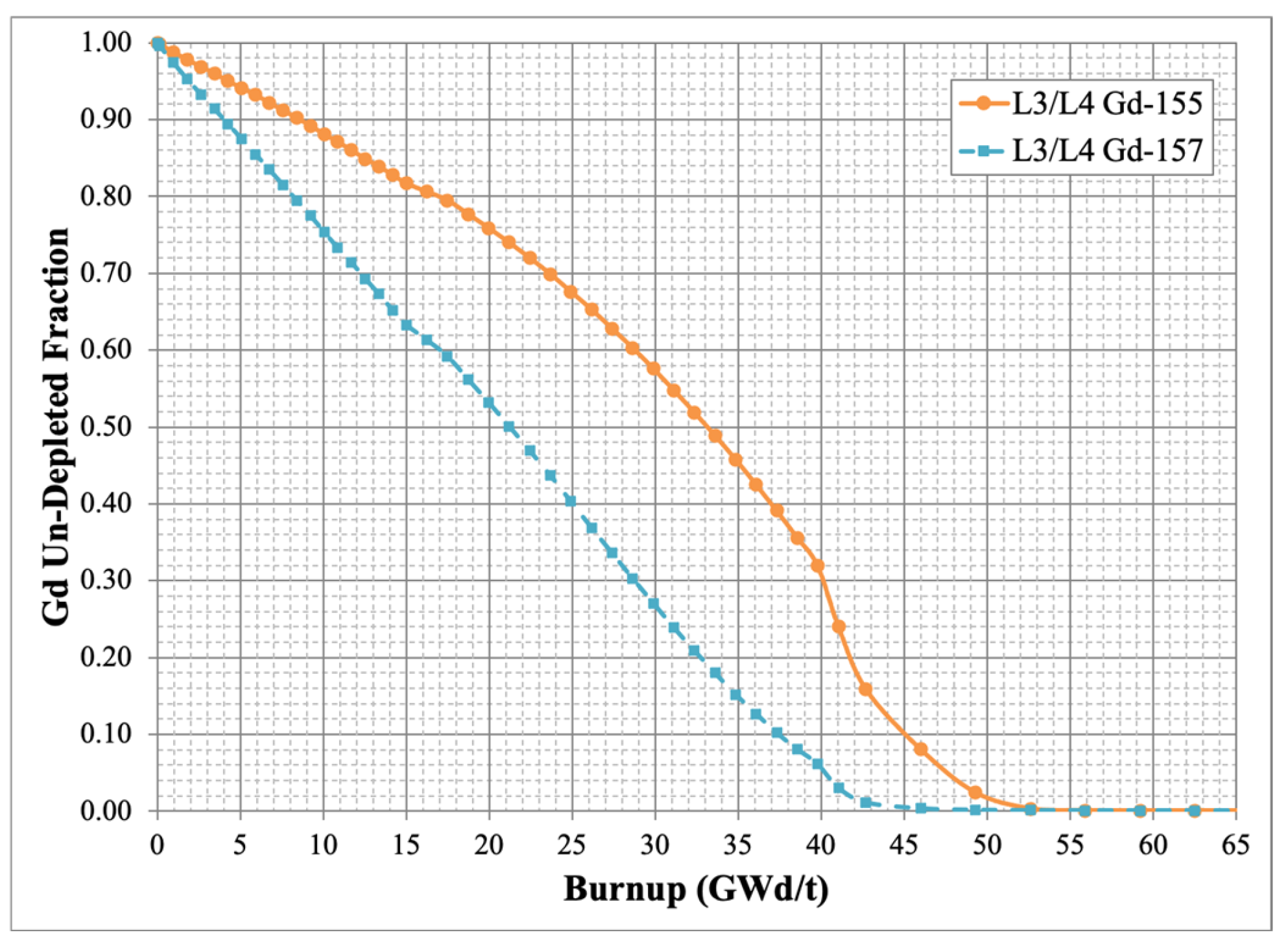


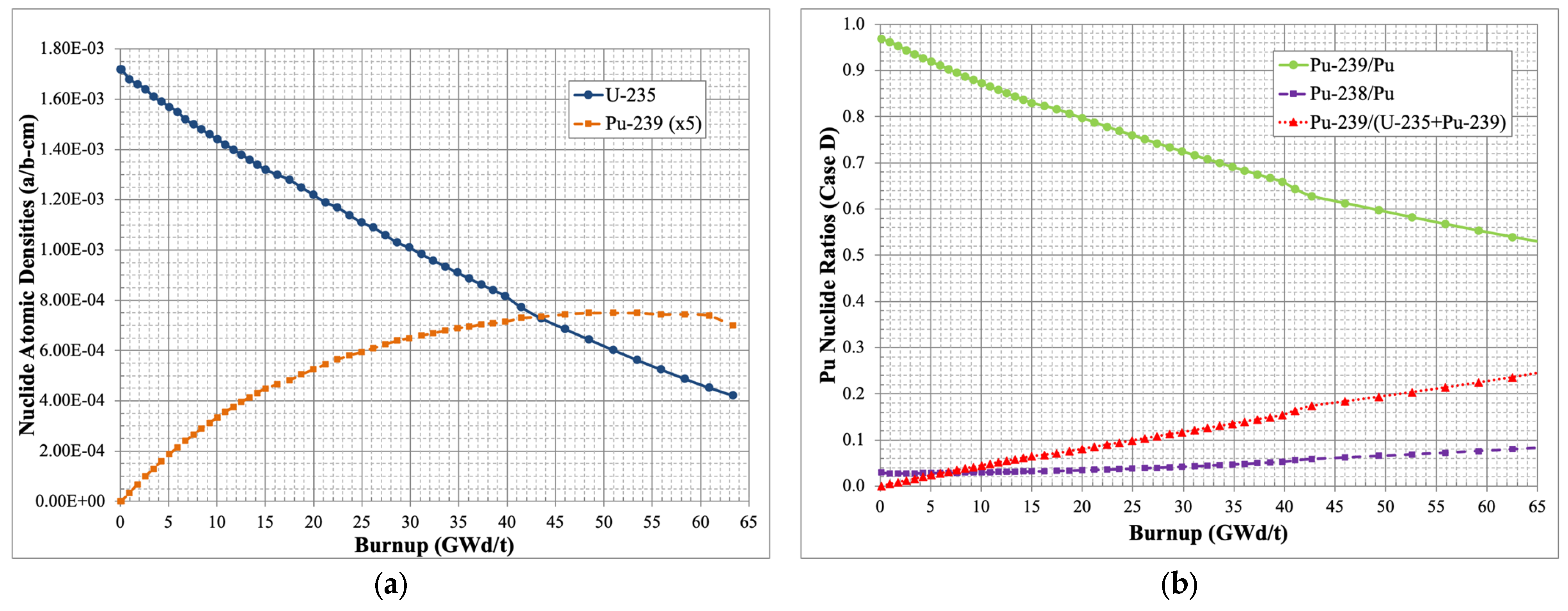
| Fuel assembly dimension | Square 21.5 cm × 21.5 cm |
| Positions per assembly | Total: 289 Fuel pins: 264 Control rod guide thimble: 24 Instrumentation thimble: 1 (center) |
| Fuel material | Uranium dioxide (UO2) |
| Cladding material | Zircaloy-4 |
| Gap filler | Helium gas |
| Fuel average density | 95% theoretical density |
| Moderator (coolant) | Water at 0.72 g/cm3 |
| Enrichment | 7.5 wt.% 235U/U |
| Fuel pellet diameter | 8.2 mm |
| Pellet–clad gap | 0.082 mm |
| Clad thickness | 0.572 mm |
| Fuel rod outer diameter | 9.5 mm |
| Fuel rod length | 135 cm |
| Isotope | Abundance (at.%) | Cross Section (b) |
|---|---|---|
| 152Gd | 0.20 | 700 |
| 154Gd | 2.18 | 60 |
| 155Gd | 14.80 | 61,000 |
| 156Gd | 20.47 | 2 |
| 157Gd | 15.65 | 255,000 |
| 158Gd | 24.84 | 2.4 |
| 160Gd | 21.86 | 1 |
| Position | L1/L6 (Top/Bottom) | L2/L5 | L3/L4 (Center) |
|---|---|---|---|
| FA-0 | 2.5 | 0 | 0 |
| FA-1 | 0 | 4.5 | 6.5 |
| FA-2 | 0 | 3.5 | 6.0 |
| FA-3 | 0.1 | 0 | 0 |
| FA-4 | 0 | 0 | 0 |
| Burnable Absorbers | 154Gd | 155Gd | 156Gd | 157Gd | 158Gd | 160Gd |
| Fission Products | 135Xe | 149Sm | ||||
| Actinides | 235U | 238U | 237Np | 238Np | 238Pu | 239Pu |
| 240Pu | 241Pu | 242Pu | 241Am | 242Am | 242Cm |
| Case B | FA-0 | FA-1 | FA-2 | FA-3 | FA-4 | Average |
|---|---|---|---|---|---|---|
| L1/L6 | 0.63 | 0.63 | 0.64 | 0.64 | 0.64 | 0.64 |
| L2/L5 | 1.53 | 1.27 | 1.10 | 0.79 | 0.65 | 1.07 |
| L3/L4 | 1.84 | 1.53 | 1.32 | 0.64 | 0.77 | 1.28 |
| Case D | FA-0 | FA-1 | FA-2 | FA-3 | FA-4 | Average |
| L1/L6 | 0.55 | 1.52 | 1.60 | 1.63 | 1.38 | 1.34 |
| L2/L5 | 0.86 | 0.40 | 0.44 | 1.62 | 1.39 | 0.94 |
| L3/L4 | 0.53 | 0.20 | 0.24 | 1.40 | 1.21 | 0.72 |
| Case B | L1/L6 | L2/L5 | L3/L4 | Case D | L1/L6 | L2/L5 | L3/L4 |
|---|---|---|---|---|---|---|---|
| FA-0 | 0.19 | 0.08 | 0.06 | FA-0 | 0.19 | 0.13 | 0.22 |
| FA-1 | 0.25 | 0.12 | 0.10 | FA-1 | 0.18 | 0.24 | 0.44 |
| FA-2 | 0.29 | 0.16 | 0.13 | FA-2 | 0.21 | 0.27 | 0.45 |
| FA-3 | 0.40 | 0.25 | 0.21 | FA-3 | 0.28 | 0.21 | 0.25 |
| FA-4 | 0.47 | 0.32 | 0.28 | FA-4 | 0.35 | 0.28 | 0.31 |
| FA Ave. | 0.32 | 0.19 | 0.16 | FA Ave. | 0.24 | 0.22 | 0.33 |
| Core Ave. | 0.22 ± 0.12 | Core Ave. | 0.27 ± 0.09 | ||||
Disclaimer/Publisher’s Note: The statements, opinions and data contained in all publications are solely those of the individual author(s) and contributor(s) and not of MDPI and/or the editor(s). MDPI and/or the editor(s) disclaim responsibility for any injury to people or property resulting from any ideas, methods, instructions or products referred to in the content. |
© 2024 by the authors. Licensee MDPI, Basel, Switzerland. This article is an open access article distributed under the terms and conditions of the Creative Commons Attribution (CC BY) license (https://creativecommons.org/licenses/by/4.0/).
Share and Cite
Bess, J.D.; Chang, G.S.; Moo, P.; Foster, J. Mini-Reactor Proliferation-Resistant Fuel with Burnable Gadolinia in Once-Through Operation Cycle Performance Verification. J. Nucl. Eng. 2024, 5, 318-329. https://doi.org/10.3390/jne5030021
Bess JD, Chang GS, Moo P, Foster J. Mini-Reactor Proliferation-Resistant Fuel with Burnable Gadolinia in Once-Through Operation Cycle Performance Verification. Journal of Nuclear Engineering. 2024; 5(3):318-329. https://doi.org/10.3390/jne5030021
Chicago/Turabian StyleBess, John D., Gray S. Chang, Patrick Moo, and Julie Foster. 2024. "Mini-Reactor Proliferation-Resistant Fuel with Burnable Gadolinia in Once-Through Operation Cycle Performance Verification" Journal of Nuclear Engineering 5, no. 3: 318-329. https://doi.org/10.3390/jne5030021







